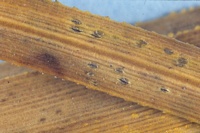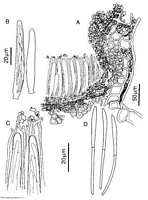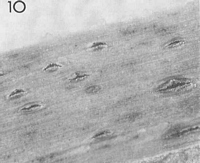|
 Marthamyces desmoschoeni Marthamyces desmoschoeni
SynonymsPropolis desmoschoeni
BiostatusPresent in region - Indigenous. Endemic
Images (click to enlarge)
Owner: Peter Johnston | 
Caption: Fig. 6 Propolis desmoschoeni. A, one side of ascoma in vertical section. B, asci. C, apices of
asci and paraphyses. D, released ascospores. (A-D, PDD 53838). | 
Caption: Fig.10 Macroscopic appearance of ascomata (xl5).Propolis desmoschoeni (PDD 48570). |
Article: Johnston, P.R. (1991). Rhytismataceae in New Zealand. 4. Pureke zelandicum gen. and sp. nov. plus additional species in Hypoderma, Lophodermium, and Propolis. New Zealand Journal of Botany 29: 395-404 (http://www.rsnz.org/publish/abstracts.php).
Description: Ascomata 0.5-1 x 0.2-0.3mm, elliptic in outline, developing within slightly bleached areas of
the host leaf, not associated with anamorph conidiomata or zone lines. Unopened ascomata
pale to dark grey, pustulate. Ascomata open by a single longitudinal slit and, after opening,
the covering host and fungal tissue folds back to expose the white, pruinose hymenium.
Ascomata develop beneath the epidermal cells and the fibre bundles on the outside of
the leaf. In vertical section the upper wall is about 10 µm thick near the base, up to 60 µm
thick near the top, and comprises brown to pale brown, thin-walled, cylindric, 2-3 µm diam.
cells, intermixed with scattered clumps of crystals. The part of the wall adjacent to the
hymenium is lined with a layer of inward-projecting, cylindric, hyaline, 10-15 x 1-2 µm,
periphysis-like cells. Fungal hyphae ramify amongst the partially broken down host tissue
covering the ascomata. The lower wall is 10-15 µm thick, of thin-walled, brown to pale
brown, cylindric cells.
Paraphyses 1-1.5 µm diam., often with short, irregular, propoloid branches near the
apex, intermixed with crystals, not extending beyond asci. Asci 80-110 x 7.5-9 µm, more or
less cylindric, tapering gradually to more or less rounded apex, wall undifferentiated at apex,
8-spored. Ascospores 60-75 x 2-3 µm, filiform-subspathulate, the widest point near the apex
but tapering rapidly distally, with the rest of the spore uniform in diam., 1-septate, gelatinous
cap at both ends.
CHARACTERISTICS IN CULTURE: Ascospores of PDD 48570 germinated on agar plates, on
oatmeal agar colonies 15-20 mm diam. after 5 weeks, aerial mycelium, low, felted, white
toward edge of colony, pale pink toward centre, pinkish in reverse.
Habitat: Dead, attached leaves of Desmoschoenus spiralis.
Notes: ETYMOLOGY: from host genus.
NOTES: P. desmoschoeni is the only species of Rhytismataceae known from
Desmoschoenus, a sand dune inhabiting sedge. It is very similar to P. dendrobii, described
from New Zealand on Dendrobium (Johnston 1986). Both species have ascomata with dark
walls, asci and ascospores about the same size, and ascospores with a distinctive swelling in
the upper half. P. dendrobii differs in having ascospores with the swelling adjacent to the
septum, close to the centre of the spore, rather than near the apex. In addition P. dendrobii
has ascomata with radiate opening slits, rather than a single longitudinal slit. This difference
may simply reflect the different textures of the host substrates, the leaves of Desmoschoenus
having a stronger linear structure than Dendrobium.
|